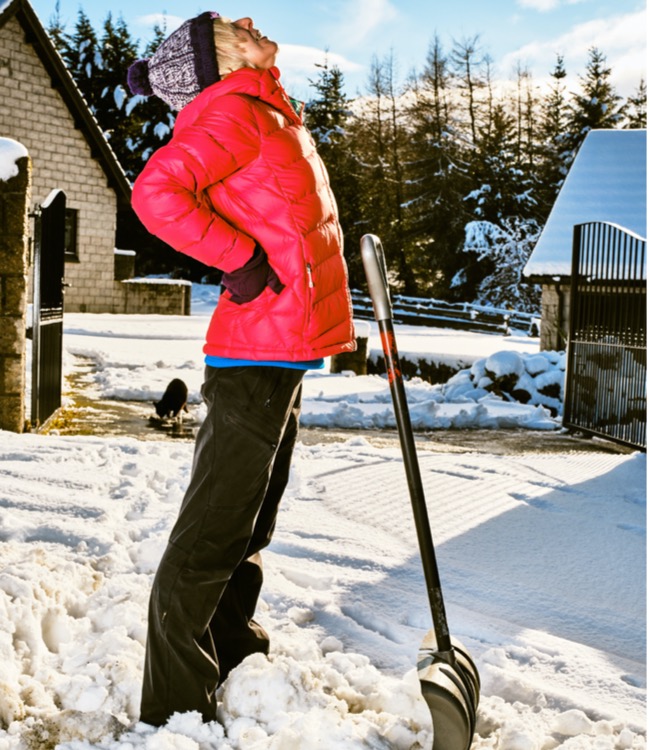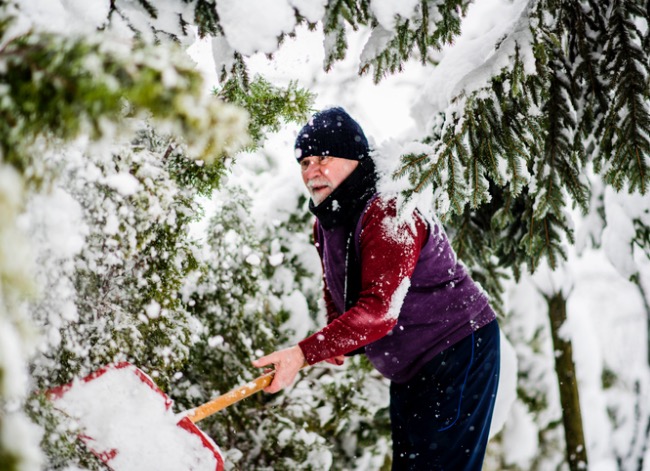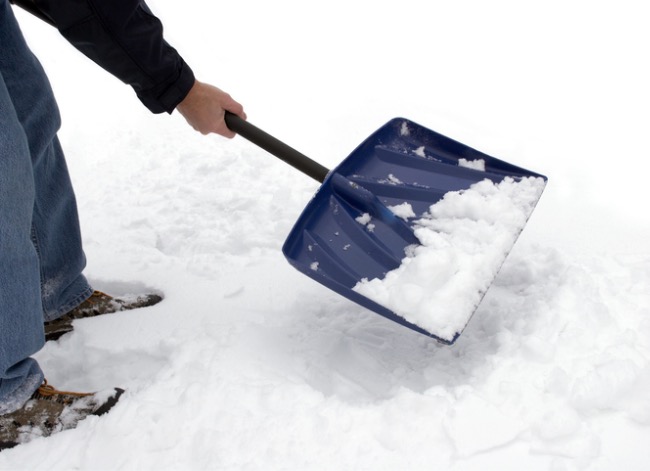We may earn revenue from the products available on this page and participate in affiliate programs. Learn More ›
Those who live in areas where snow falls throughout the winter may marvel at its beauty, but dread the work it brings. As the white stuff accumulates, it’s your responsibility to grab your snow shovel and set to work.
Shoveling snow requires intense exertion in cold temperatures, which can spell trouble for your physical wellbeing. There’s danger of slipping on ice, hypothermia from freezing temperatures, and strain from heavy lifting, all of which can impact your health. Each year on average, snow shoveling is the cause of 100 deaths and 11,500 injuries in the United States. Before getting out there to shovel snow, be prepared for the potential risks of the job.
1. Back Strain
Before starting a workout, the common advice is to warm up your muscles first. Cold muscles are tighter, making them more vulnerable to strain. Back muscles are at risk of straining or spasming for those who are unaccustomed to physical activity, use an improper technique, or push themselves too much. Before heading outside, do 10 minutes of light exercise to prepare your muscles before shoveling.
To reduce strain on your back, select a snow shovel with a small, lightweight plastic blade, which limits the amount you can lift. We like Snow Joe’s ergonomic strain-reducing shovel, which has a spring-assist handle.
RELATED: We Tested the Best Snow Shovels, and Our Favorite Makes Lifting Heavy Snow Easier on Everyone

2. Heart Strain
Shoveling snow is more strenuous than many people think. The exertion from lifting heavy snow can trigger a heart attack, especially in colder weather. In the cold, arteries tend to constrict, which drives up blood pressure. When part of the heart muscle doesn’t receive enough blood flow, heart attacks can occur.
To protect your heart from overexertion, divide the work into smaller segments and take breaks rather than powering through the entire job. Should you feel any signs of a heart attack (chest pain, trouble breathing, pain that radiates down the arm or neck), seek medical care right away. If you have pre-existing medical conditions, consider hiring a neighborhood kid to shovel the driveway for you.
RELATED: We Cleared Nearly 400 Feet of Pavement to Find the 10 Best Snow Blowers

3. Respiratory Problems
Though the cold, fresh air can feel good, extreme cold can actually irritate the lungs and affect your breathing. Cold, dry air can cause the upper airway to narrow, making it a bit more difficult to breathe, especially for those with conditions such as asthma, bronchitis, or chronic obstructive pulmonary disease (COPD).
When shoveling, if you have trouble breathing, experience a feeling of tightness in your chest, or start to cough or wheeze, put down your shovel and head indoors.
One tip to minimize respiratory issues while shoveling is to cover your nose and mouth with a scarf or gaiter, which will help warm the air before it enters your lungs.
RELATED: The 14 Best Tools for Conquering Ice and Snow

4. Frostbite
Those in colder climates should beware of the potential for frostbite. When exposed to extreme cold, blood circulation moves away from extremities and to the internal organs and brain to keep the body functioning. Limited blood flow to the skin and extremities (like fingers, hands, toes, feet, nose, ears, etc.), causes ice crystals to form and results in frozen tissue.
When you head outside to shovel, it’s likely cold, wet, and windy. Get out of the cold if you notice skin with any signs of redness or pain. To avoid frostbite, check the weather, temperature, and wind chill and dress in appropriate layers to stay warm. If it’s especially cold and you’ll be outside for a prolonged period of time, consider perusing our researched guides on heated jackets and heated vests, which will offer shovelers more protection from frigid weather.

5. Dehydration
Dehydration is a health condition that can sneak up on you in cold weather. People generally feel less thirsty in the cold, and will skip out on the water they need without realizing it. Dehydration can impair your body’s ability to regulate heat and can put more stress on your heart.
Often, snow shoveling is a chore undertaken in the morning when people clear the driveway before starting their day. This time is when we’re the least hydrated, and the physical effort of shoveling tends to generate sweat, making us lose water that we’re not replacing.
Symptoms of dehydration include thirst, dry mouth, swollen tongue, weakness, dizziness, heart palpitations, among others. To combat the condition, drink a large glass of water about 30 minutes before tackling the driveway and take regular breaks to rehydrate.

Proper Shoveling Technique
Learning the right way to shovel snow helps minimize potential health risks. The best way to shovel is to bend at the knees, keep the blade as close as possible to the body, and push up with the legs when you lift. Lifting with the legs, instead of the upper body or back, reduces strain to the back muscles. Choking up on the shovel also creates a safer, more stable grip.
Avoid the dangers of lifting and throwing shovels of heavy snow, and consider a shovel that pushes snow or a snow blower instead.
RELATED: We Cleared More Than 4 Feet Of Snow Testing the Best Electric Snow Shovels and Found 9 Top Options
Dress for Success
Dressing appropriately for cold weather does wonders when it comes to reducing the health risks associated with shoveling snow. Layered clothing is ideal because it can be added or removed as needed. A synthetic base layer, like these from Thermajohn, wicks moisture away from the skin. Avoid cotton, as it doesn’t wick away sweat, and lacks the insulation to keep you warm.
Make sure you cover your head, hands, and feet properly with a hat, gloves, and thick socks, items that can all be found on Amazon. On your feet, wear boots with slip-resistant soles to ensure you remain upright, even in icy conditions.


